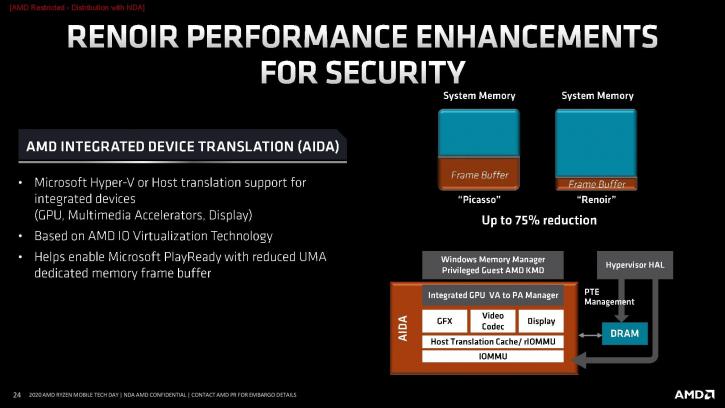Renoir Architecture
Renoir Architecture
The increase in the number of x86 cores is expected to have an impact on the CPU component area (the number of cores has doubled), which is now superior to iGPU. Renoir processors are still based on the Zen 2 architecture and continue to inherit quad-core CCX complexes, from which the CPU is formed.
A significant difference between CCX Renoir and CCX Matisse or Rome is a reduced L3 cache now at 4MB per CCX against the 16MB we could see on processors without integrated GPUs (iGPU).
But do not despair, meet the new memory controller. You can now bump up DRAM frequencies towards 4600 MHz in 1:1 mode (FCLK:MEMCLK) thanks to an updated memory controller. To be more precise, the APU has two memory controllers, each of which supports 1x64 for DDR4 and 2x32 virtual channels for LPDDR4x memory.
To fully realize the increased memory bandwidth, AMD doubled the width of the Infinity Fabric, the interconnect that binds the chip blocks together. AMD states that the improved bandwidth improves the energy efficiency of interconnections, and new dynamic power states provide up to 75% improvement in energy efficiency. This means that the Infinity Fabric has built-in "throttling" that allows the width of the bus to be changed on the fly, which can ultimately have a negative impact when using high frequencies.
The memory controllers are based on a 7nm process and are very close to the CCX, which in turn has led to a significant reduction in the "fine" for latency since no longer used long-distance links. As it was before, RAM and IF overclocking will significantly improve arithmetic performance of the processor and at the same time the performance of the built-in iGPU, which uses RAM as a video buffer.
Having undergone changes in load balancing between cores, AMD claims a 5x reduction in input/output time for idle states thanks to updated ACPI data and improved telemetry data transmitted via Infinity Fabric and SMC (System Management Controller). In fact, this will allow the processor to adapt to each task with greater energy efficiency.
Integrated graphics Vega on GCN 5.0 architecture received a maximum of 8 Compute Units, which corresponds to 512 thread processors. This is less than the previous Picasso APUs, which could boast 11 CU. Built-in video core allows you to reach a record 1.79 teraflops FP32 with consumption of only 15W.
Such a high score was achieved thanks to a 7nm process, higher clock frequency and several architectural improvements. A nice bonus is the possibility of manual overclocking of iGPU, while the kernel frequency will not float. In a few clicks it is possible to overclock the video core to 2400 MHz, which in the case of 4650G with 7CU will produce 2100 teraflops FP32.
At the moment, this is half the performance of the Radeon RX 5500 XT. Such a solution can cope not only with several games of the past decade, but also allows you to play without problems in Battlefield V in 1080p. Yeah, yeah, you didn't mishear that.
The multimedia engine Radeon Display Controller Next 2, received a 31% increase in encoder performance. The entire Renoir family supports VP9 8b / 10b decoding at 1080p240 or 4K60 resolution, as well as encoding and decoding for H.264 and H.265.
The PCI bus configuration has not changed. The user still has 20 PCIe lines available with the third version of PCI Express. In this case, senior desktop APUs will be able to offer 16 lines for the slot PCI-express x16, which is installed discrete graphics card, 4 CPU lines for NMVE and four wires (lanes) from the chipset B550.
As far as energy efficiency is concerned, it has improved, but not much. In our material about Zen2 architecture, there was an extensive test of frequency dependence on voltage in Linx 0.7.0. For the 4200MHz, Matisse needed 1.35V, now for the 4650G only 1.2875V. Less cache, more mature process will allow to get an additional 75-100 MHz. Both processors have a silicon wafer manufacturing facility in China (SUT/SUS), indicating - do not expect outstanding overclocking. If you want more, look for processors marked with PGT.
Boost. Fortunately, even at the heaviest of loads, the processor speed didn't drop below 4150 MHz, and in games, it's always 4300-4275. The above chart is the boost frequency dependence on the number of cores involved, using Cinebench 20 as an example.











